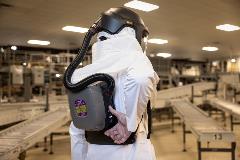Essential Elements of Respirator Selection

NIOSH has designated the week of September 3-6, 2024, as Respiratory Protection Week. Formerly known as “N95 Day”, this week-long observance highlights the importance of respiratory protection in the workplace and provides resources to help users make educated decisions when selecting and wearing a respirator. If you are exposed to respiratory hazards at work, chances are respiratory protection is a major building block of your PPE program.
OSHA 29 CFR 1910.134 requires employers to establish and maintain a written respiratory program to protect their employees who wear respirators, which includes the following factors:
- A written program detailing specific procedures for your worksite
- Implementation of equipment and procedures to reduce respiratory hazards
- Selection of an appropriate NIOSH-approved respirator
- Training of employees in proper respirator use and hazard recognition
 Proper fit testing, inspection, cleaning, maintenance, and storage of respirators
Proper fit testing, inspection, cleaning, maintenance, and storage of respirators- Medical surveillance and evaluation of employees
- Monitoring of air quality standards in your work area
- Periodic evaluation of program implementation and compliance
Additionally, the proper selection of respirators must be made according to the guidance of ANSI Z88.2. Selecting the right equipment involves several steps:
1. Identify the Contaminant: Always consult the Material Safety Data Sheet (MSDS) for each chemical used in the work process. The physical form of the contaminant will help determine the type of respiratory protection needed.
2. Determine the Concentration Level: Perform air monitoring to determine the concentration level of the contaminant in the work area. If the level is higher than the Permissible Exposure Limit (PEL) for the substance, precautionary measures must be taken. If the employer cannot identify or “reasonably estimate” the employee exposure, the atmosphere must be considered Immediately Dangerous to Life or Health (IDLH).
3. Evaluate the Conditions of Exposure: The nature and context of the hazard, work rate, area to be covered, mobility, work requirements and conditions as well as the limitations and characteristics of the available respirators, are also factors.
4. Choose the Proper Respirator: The respirator should provide protection against the hazard for which it was designed. Respirators are classified according to the respiratory hazard, and the two main categories of respirators are air-purifying respirators and air-supplying respirators.

5. If the atmosphere is determined to be IDLH, a full facepiece certified SCBA or a full facepiece pressure demand airline respirator with auxiliary self-contained air supply must be used.

a. If the atmosphere is not determined to be IDLH, the employer must provide a respirator that is appropriate for the contaminant(s) identified.
b. Respirator training, medical evaluations and qualitative or quantitative fit testing must be provided at no cost to the employees.
Connect with Saf-T-Gard to Learn More
Saf-T-Gard has your respiratory protection needs covered with our comprehensive selection of disposable respirators, reusable half-mask and full facepiece respirators, cartridges and filters, powered and supplied air systems, escape respirators and respiratory protection accessories available in many different filter classes, connections and assemblies to protect against a broad range of dusts, particles, chemicals, vapors, mists and sprays, gasses, fumes, smoke and more. Respiratory fit testing services are also available to complete your respiratory safety program. Industrial safety is our legacy going back 9 decades. For an overview of our respiratory protection products, and to order for immediate shipment, please visit Respiratory Protection.

